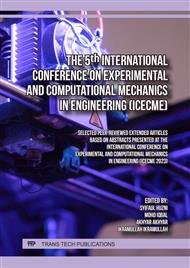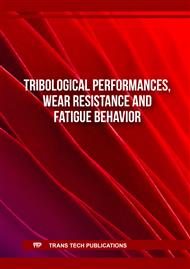[1]
E. A. Chinnov, F. V Ron'Shin, and O. A. Kabov, "Regimes of two-phase flow in micro-and minichannels," Thermophys. aeromechanics, vol. 22, p.265–284, 2015.
DOI: 10.1134/s0869864315030014
Google Scholar
[2]
Z. Aidoun, K. Ameur, M. Falsafioon, and M. Badache, "Current advances in ejector modeling, experimentation and applications for refrigeration and heat pumps. Part 2: two-phase ejectors," Inventions, vol. 4, no. 1, p.16, 2019.
DOI: 10.3390/inventions4010016
Google Scholar
[3]
R. R. Souza et al., "Recent advances on the thermal properties and applications of nanofluids: From nanomedicine to renewable energies," Appl. Therm. Eng., vol. 201, p.117725, 2022.
Google Scholar
[4]
Sukamta, E. Roziantho, and Sudarja, "Experimental study on two-phase flow of gas-liquid with high viscosity in capillary with the slope of 5° against horizontal position," J. Adv. Res. Fluid Mech. Therm. Sci., vol. 69, no. 2, p.120–129, 2020.
DOI: 10.37934/arfmts.69.2.120129
Google Scholar
[5]
K. Sefiane and A. Koşar, "Prospects of heat transfer approaches to dissipate high heat fluxes: Opportunities and challenges," Appl. Therm. Eng., p.118990, 2022.
DOI: 10.1016/j.applthermaleng.2022.118990
Google Scholar
[6]
K. Krisdiyanto, R. K. Adi, S. Sudarisman, and S. Bin Hamdan, "An Analysis of Tube Thickness Effect on Shell and Tube Heat Exchanger," Eastern-European J. Enterp. Technol., vol. 1, no. 8, p.109, 2021.
DOI: 10.15587/1729-4061.2021.225334
Google Scholar
[7]
S. Sun et al., "Microstructural effects on permeability of Nitrocellulose membranes for biomedical applications," J. Memb. Sci., vol. 595, p.117502, 2020.
Google Scholar
[8]
A. Kawahara, P. Y. Chung, and M. Kawaji, "Investigation of two-phase flow pattern, void fraction and pressure drop in a microchannel," Int. J. Multiph. Flow, vol. 28, no. 9, p.1411–1435, 2002.
DOI: 10.1016/S0301-9322(02)00037-X
Google Scholar
[9]
L. Cheng and G. Xia, "Flow patterns and flow pattern maps for adiabatic and diabatic gas liquid two phase flow in microchannels: fundamentals, mechanisms and applications," Exp. Therm. Fluid Sci., vol. 148, no. June, p.110988, 2023, doi: 10.1016/j.expthermflusci. 2023.110988.
DOI: 10.1016/j.expthermflusci.2023.110988
Google Scholar
[10]
Sukamta and Sudarja, Correlation between void fraction and two-phase flow pattern air-water with low viscosity in mini channel with slope 30 degrees, vol. 846 KEM. 2020.
DOI: 10.4028/www.scientific.net/KEM.846.289
Google Scholar
[11]
G. Ribatski, "Micro- and Macro-Scale Channels," no. 2011, p.18–22, 2012.
Google Scholar
[12]
S. Sukamta, D. A. Saputra, S. Sudarja, S. Sundari, and R. K. Adi, "Void Fraction of Two-Phase Flow of Air–Emulsion of Water and Oil in Horizontal Mini Pipe," J. Adv. Res. Fluid Mech. Therm. Sci., vol. 110, no. 1, p.121–130, 2023.
DOI: 10.37934/arfmts.110.1.121130
Google Scholar
[13]
A. Asyidiq, S. Sukamta, S. Sudarja, and R. K. Adi, "Investigation of the two-phase air pressure gradient of water and glycerin (40-70%) in a capillary pipe with a 30° inclination to the horizontal position," in AIP Conference Proceedings, AIP Publishing, 2024.
DOI: 10.1063/5.0207554
Google Scholar
[14]
Á. R. Gardenghi, E. D. S. Filho, D. G. Chagas, G. Scagnolatto, R. M. Oliveira, and C. B. Tibiriçá, "Overview of void fraction measurement techniques, databases and correlations for two-phase flow in small diameter channels," Fluids, vol. 5, no. 4, p.216, 2020.
DOI: 10.3390/fluids5040216
Google Scholar
[15]
H. Qian and P. Hrnjak, "Void fraction measurement and flow regimes visualization of R134a in horizontal and vertical ID 7 mm circular tubes," Int. J. Refrig., vol. 103, p.191–203, 2019.
DOI: 10.1016/j.ijrefrig.2019.04.018
Google Scholar
[16]
R. Dyga and M. Płaczek, "Influence of hydrodynamic conditions on the type and area of occurrence of gas-liquid flow patterns in the flow through open-cell foams," Materials (Basel)., vol. 13, no. 15, 2020.
DOI: 10.3390/MA13153254
Google Scholar
[17]
Krisdiyanto, R. K. Adi, and Gunawan, "Analysis of the Syringe Barrel Angle Effect," in AIP Conference Proceedings, AIP Publishing, 2022.
DOI: 10.1063/5.0105210
Google Scholar
[18]
K. A. Triplett, S. M. Ghiaasiaan, S. I. Abdel-Khalik, A. LeMouel, and B. N. McCord, "Gas–liquid two-phase flow in microchannels: part II: void fraction and pressure drop," Int. J. Multiph. Flow, vol. 25, no. 3, p.395–410, 1999.
DOI: 10.1016/s0301-9322(98)00055-x
Google Scholar
[19]
D. C. Adams, J. Burr, P. Hrnjak, and T. Newell, "Void fraction of CO2 and ammonia in multiport aluminum microchannel tubes," 2006.
Google Scholar
[20]
E. X. Barreto, J. L. G. Oliveira, and J. C. Passos, "Frictional pressure drop and void fraction analysis in air-water two-phase flow in a microchannel," Int. J. Multiph. Flow, vol. 72, p.1–10, 2015.
DOI: 10.1016/j.ijmultiphaseflow.2015.01.008
Google Scholar
[21]
R. Kurimoto, K. Nakazawa, H. Minagawa, and T. Yasuda, "Prediction models of void fraction and pressure drop for gas-liquid slug flow in microchannels," Exp. Therm. Fluid Sci., vol. 88, p.124–133, 2017.
DOI: 10.1016/j.expthermflusci.2017.05.014
Google Scholar
[22]
L. Cheng, "Flow patterns and bubble growth in microchannels," in Microchannel Phase Change Transport Phenomena, Elsevier, 2016, p.91–140.
DOI: 10.1016/b978-0-12-804318-9.00003-0
Google Scholar
[23]
S. Sukamta, A. R. Ilham, and S. Sudarja, "the Investigation of Void Fraction of Two-Phase Flow Air-Water and Glycerine (0-30%) in the Capillary Pipe With Slope of 50 To Horizontal Position," Media Mesin Maj. Tek. Mesin, vol. 20, no. 1, p.8–17, 2019.
DOI: 10.23917/mesin.v20i1.7385
Google Scholar
[24]
G. B. Wallis, One-dimensional two-phase flow. Courier Dover Publications, 2020.
Google Scholar
[25]
S. D. Odeh, G. L. Morrison, and M. Behnia, "Modelling of parabolic trough direct steam generation solar collectors," in Renewable Energy, Routledge, 2018, p. Vol2_487-Vol2_506.
DOI: 10.4324/9781315793245-79
Google Scholar
[26]
S. G. Kandlikar, "Fundamental issues related to flow boiling in minichannels and microchannels," Exp. Therm. fluid Sci., vol. 26, no. 2–4, p.389–407, 2002.
DOI: 10.1016/s0894-1777(02)00150-4
Google Scholar
[27]
Z. Fazliogullari, A. K. Karabulut, N. Unver Dogan, and I. I. Uysal, "Coronary artery variations and median artery in Turkish cadaver hearts," Singapore Med. J., vol. 51, no. 10, p.775–780, 2010.
Google Scholar
[28]
M. Sharan and A. S. Popel, "A two-phase model for flow of blood in narrow tubes with increased effective viscosity near the wall," Biorheology, vol. 38, no. 5–6, p.415–428, 2001.
DOI: 10.1177/0006355x2001038005006005
Google Scholar
[29]
K. A. Triplett, S. M. Ghiaasiaan, S. I. Abdel-Khalik, and D. L. Sadowski, "Gas-liquid two-phase flow in microchannels part I: Two-phase flow patterns," Int. J. Multiph. Flow, vol. 25, no. 3, p.377–394, Apr. 1999.
DOI: 10.1016/S0301-9322(98)00054-8
Google Scholar



